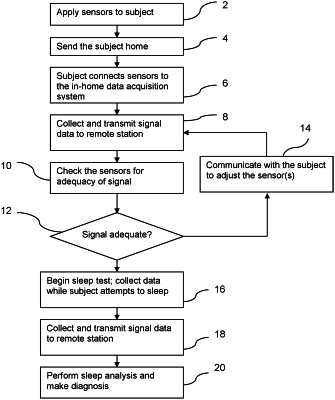| CPC A61B 5/4815 (2013.01) [A61B 5/0022 (2013.01); A61B 5/0077 (2013.01); A61B 5/0205 (2013.01); A61B 5/0806 (2013.01); A61B 5/1114 (2013.01); A61B 5/14551 (2013.01); A61B 5/318 (2021.01); A61B 5/369 (2021.01); A61B 5/389 (2021.01); A61B 5/398 (2021.01); A61B 5/4812 (2013.01); A61B 5/4818 (2013.01); A61B 5/6801 (2013.01); A61B 5/6814 (2013.01); A61B 5/6828 (2013.01); A61B 5/7264 (2013.01); G16H 40/67 (2018.01); A61B 5/024 (2013.01); A61B 5/085 (2013.01); A61B 5/087 (2013.01); A61B 5/1135 (2013.01); A61B 5/14552 (2013.01); A61B 2505/07 (2013.01); A61B 2560/0242 (2013.01); A61B 2560/0431 (2013.01); A61B 2562/0219 (2013.01); A61B 2562/0261 (2013.01)] | 20 Claims |

|
1. A sleep diagnostic system for testing multiple subjects at multiple remote locations for sleep apnea comprising:
a) a first software stored on a first non-transitory computer readable medium and adapted to be executable by a first processor on a cellular phone, the cellular phone comprising a memory, the first processor and a first wireless transceiver;
b) a database stored on a second non-transitory computer readable medium adapted to operate with one or more servers at a first or multiple locations for receiving and transmitting data to and from the database;
c) a second software stored on the second, and/or a third non-transitory computer readable medium and adapted to be executable by a second processor at the first location, a second location and/or the multiple locations configured to process, in part, the data;
d) multiple portable, wearable patient interface boxes, each portable, wearable patient interface box adapted to be worn by a subject during testing at a remote sleep location remote from a sleep analysis unit or lab, and the first, the second and/or the multiple locations where the database and/or the second software are operating, one or more of the multiple portable, wearable patient interface boxes comprising
i) a battery;
ii) electronics including at least two input channels, which are programmed to receive collected data in real-time from at least two sensors internal to the portable, wearable patient interface box; and
iii) a second wireless transceiver or transmitter adapted to wirelessly transmit the data collected from the two sensors internal to the portable, wearable patient interface box, and/or data based on the data collected to the first software on the cellular phone;
e) the two sensors are selected from a group consisting of: accelerometer(s), fingertip pulse oximeter(s), pressure sensor(s), microphone(s), strain gauge(s), pressure transducer(s), and transducer(s), the portable, wearable patient interface box containing the two sensors adapted
i) to be applied to a finger, wrist, arm or torso of the subject; and
ii) to allow to be measured, calculated and/or derived two or more of the following sleep data: airflow, snore, changes in pulse, changes in heart rate, changes in sleep state, respiratory effort, body movement and/or position, tidal volume, ventilation rate and blood oxygenation of the subject during testing;
f) the database being accessible to individuals from the sleep analysis unit or lab, and adapted to receive the collected data and/or data based on the collected data;
g) the first software and/or the second software when executed respectively by the first and/or second processors is configured to automatically identify and quantify physiological events in one or more of the changes in pulse and/or heart rate, body position, and blood oxygenation, from the data that was transferred from the portable, wearable patient interface box, the physiological events indicative of a sleeping disorder, the second software further adapted to be executed by the one second processor to output through a communication device; and
h) the communication device adapted to output
i) one or more of the following sleep data: airflow, snore, changes in pulse, changes in heart rate, changes in sleep state, respiratory effort, body movement and/or position, tidal volume, ventilation rate and blood oxygenation of the subject from the database,
ii) the identified and quantified physiological events in the data, or
iii) both i) and ii) in a form adapted so a professional medical diagnosis can be made of whether the patient suffers from a sleep disorder.
|